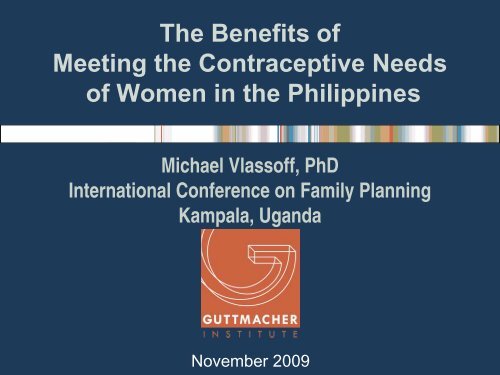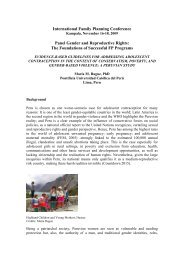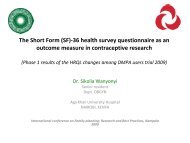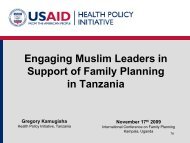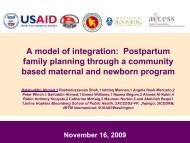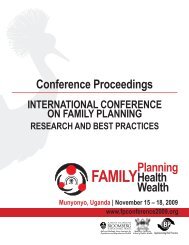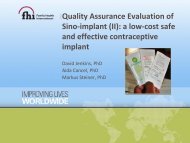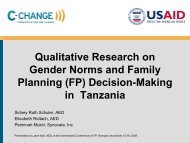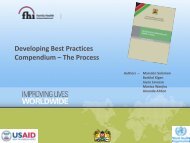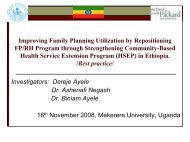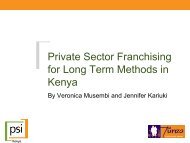The Benefits of Meeting the Contraceptive Needs of - International ...
The Benefits of Meeting the Contraceptive Needs of - International ...
The Benefits of Meeting the Contraceptive Needs of - International ...
Create successful ePaper yourself
Turn your PDF publications into a flip-book with our unique Google optimized e-Paper software.
<strong>The</strong> <strong>Benefits</strong> <strong>of</strong><br />
<strong>Meeting</strong> <strong>the</strong> <strong>Contraceptive</strong> <strong>Needs</strong><br />
<strong>of</strong> Women in <strong>the</strong> Philippines<br />
Michael Vlass<strong>of</strong>f, PhD<br />
<strong>International</strong> Conference on Family Planning<br />
Kampala, Uganda<br />
November 2009
Overview<br />
• Context: Fertility and health<br />
• Objective <strong>of</strong> <strong>the</strong> study<br />
• Methodological approach<br />
• Impacts <strong>of</strong> contraceptive use –<br />
pregnancy, health, and financial<br />
outcomes<br />
• Conclusion
Context and Objectives
Filipino women are having more children<br />
than <strong>the</strong>y want, especially if <strong>the</strong>y are poor<br />
Births per woman, 2003<br />
7<br />
6<br />
5<br />
4<br />
3<br />
2<br />
1<br />
0<br />
2.5<br />
3.5<br />
3.8<br />
5.9<br />
3.1<br />
4.6<br />
2.6<br />
Wanted fertility Actual fertility<br />
Philippines Lowest Second Middle Fourth Highest<br />
3.5<br />
Wealth Quintiles<br />
2.2<br />
2.8<br />
1.7<br />
2.0
Maternal and child health situation<br />
• Philippines<br />
needs improvement<br />
– MMR <strong>of</strong> 230 per 100,000 live births (2005)<br />
– IMR <strong>of</strong> 30 per 1000 live births (2003)<br />
– Maternal DALYS <strong>of</strong> 503,000 (2004)
<strong>Contraceptive</strong> use<br />
in <strong>the</strong> Philippines is inadequate<br />
• <strong>Contraceptive</strong> use is relatively low<br />
• Use has not changed much in recent<br />
years<br />
• Many contraceptive users rely on<br />
traditional methods that have high use-<br />
failure rates
Objectives <strong>of</strong> <strong>the</strong> study<br />
• Help policymakers improve health and<br />
family well-being in <strong>the</strong> Philippines<br />
• Estimate <strong>the</strong> costs and benefits <strong>of</strong><br />
contraceptive use<br />
• Special emphasis on poor women and<br />
regions
Methodological Approach
Definition: Women at Risk for<br />
Unintended Pregnancy<br />
• Sexually active<br />
– Married women 15-49<br />
– Unmarried women 15-49 who had sex in last 3 months<br />
• Fecund<br />
– No evidence <strong>of</strong> infecundity from women’s reports<br />
– No long period <strong>of</strong> sexually activity with no contraceptive<br />
use, but no pregnancy<br />
• Do not want a(no<strong>the</strong>r) child soon:<br />
– Not in <strong>the</strong> next 2 years (Spacing)<br />
– Want no (more) children at all (Limiting)
Data input and <strong>the</strong>ir sources<br />
• Number <strong>of</strong> women 15-49, by region, in 2008<br />
– Philippines censuses and projections<br />
• Distributed women 15-49 in each region by<br />
marital status and DHS wealth index<br />
– 2003 DHS<br />
• Distributed women by risk and contraceptive use<br />
status, according to <strong>the</strong>ir region, marital status<br />
and DHS wealth index<br />
- 2003 DHS<br />
• Cost from various sources: DKT, PhilHealth,<br />
DOH, PRISM publication, etc.
Unintended pregnancies according<br />
to contraceptive use and nonuse<br />
Numbers <strong>of</strong> women at risk<br />
in each region<br />
using each method or nonuse<br />
x<br />
Use-failure/pregnancy rates<br />
for each method and nonuse<br />
adjusted to regional unintended pregnancies<br />
Numbers <strong>of</strong> unintended pregnancies<br />
in each region<br />
by method used or nonuse
Alternate scenarios show impacts<br />
<strong>of</strong> contraceptive use<br />
• Assuming <strong>the</strong> desire for pregnancy, sexual<br />
exposure and risk for unintended pregnancy<br />
remain <strong>the</strong> same, we considered a number <strong>of</strong><br />
scenarios:<br />
– No contraceptive use<br />
– Current method use<br />
– Natural methods used by all women at risk<br />
– Current method mix used by all at risk<br />
– Modern methods used by all at risk
Impacts <strong>of</strong> contraceptive use
Women not using modern methods<br />
account for 9 in 10 unintended<br />
Modern<br />
methods<br />
49%<br />
No<br />
method<br />
29%<br />
Trad.<br />
methods<br />
22%<br />
Women at risk for unintended<br />
pregnancy<br />
pregnancies<br />
Modern<br />
methods<br />
8%<br />
Trad.<br />
method<br />
s<br />
24%<br />
No<br />
method<br />
68%<br />
Unintended pregnancies
<strong>Contraceptive</strong> use reduces abortion<br />
and unplanned childbearing<br />
Millions <strong>of</strong> pregnancies<br />
7<br />
6<br />
5<br />
4<br />
3<br />
2<br />
1<br />
0<br />
5.9<br />
1.5<br />
2.9<br />
3.4<br />
0.6<br />
3.2<br />
0.6<br />
1.3 1.1<br />
1.5 1.5 1.5 1.5 1.5<br />
No method use Current method use NFP methods used<br />
by all<br />
2.4<br />
0.3<br />
0.6<br />
Current method mix<br />
used by all<br />
Intended pregnancies Unplanned births and miscarriages Abortions<br />
1.8<br />
0.1<br />
0.2<br />
Modern methods<br />
used by all
<strong>Contraceptive</strong> use protects health<br />
Maternal deaths<br />
9,000<br />
8,000<br />
7,000<br />
6,000<br />
5,000<br />
4,000<br />
3,000<br />
2,000<br />
1,000<br />
0<br />
8,200<br />
2480<br />
3641<br />
4,600<br />
946<br />
958<br />
1636 1406<br />
387<br />
571<br />
2060 2060 2060 2060 2060<br />
No method use Current method<br />
mix (71% use)<br />
4,400<br />
NFP methods used<br />
by all women at<br />
risk<br />
3,000<br />
Current method<br />
mix used by all<br />
women at risk<br />
Intended pregnancies Unplanned births and miscarriages Abortions<br />
2,500<br />
163<br />
249<br />
Modern methods<br />
used by all women<br />
at risk
Cost in million USD<br />
300<br />
250<br />
200<br />
150<br />
100<br />
50<br />
0<br />
Improving contraceptive use<br />
272.1<br />
184.4<br />
saves money<br />
209.1<br />
42.7<br />
65.2<br />
78.7 71.9<br />
60.7<br />
87.7 87.7 87.7 87.7 87.7<br />
No method use Current method<br />
use<br />
224.8<br />
NFP methods<br />
used by all<br />
184.4<br />
36<br />
Current method<br />
mix used by all<br />
191.2<br />
90<br />
13.5<br />
Modern<br />
methods used<br />
by all<br />
Medical costs <strong>of</strong> intended pregnancies Medical costs <strong>of</strong> unintended pregnancies Family planning costs
Conclusion<br />
• Increasing contraceptive use promotes<br />
health and welfare<br />
• Investment in contraceptive services<br />
has financial benefits<br />
• <strong>The</strong> case for additional funding <strong>of</strong><br />
contraceptive use is compelling
This study was undertaking and<br />
this presentation was developed<br />
with support from AusAID.<br />
For more information, visit www.guttmacher.org


